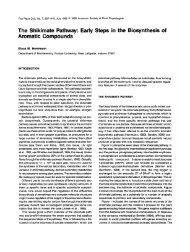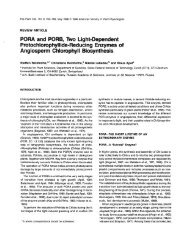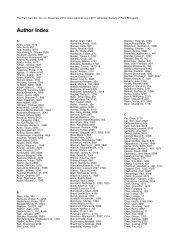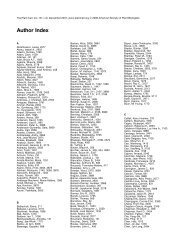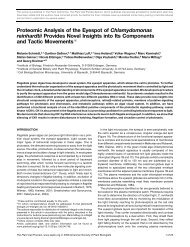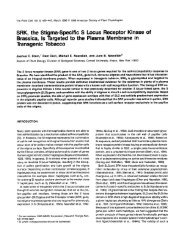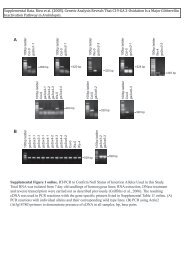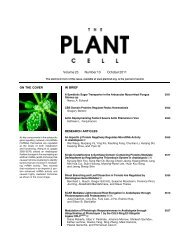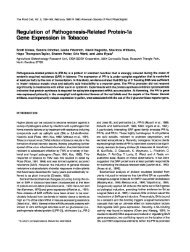The Angiosperm Gibberellin-GID1-DELLA Growth ... - The Plant Cell
The Angiosperm Gibberellin-GID1-DELLA Growth ... - The Plant Cell
The Angiosperm Gibberellin-GID1-DELLA Growth ... - The Plant Cell
Create successful ePaper yourself
Turn your PDF publications into a flip-book with our unique Google optimized e-Paper software.
2 of 12 <strong>The</strong> <strong>Plant</strong> <strong>Cell</strong><br />
Figure 1. GA Structure and Response Mutant Categories.<br />
(A) <strong>The</strong> structure of a bioactive GA (GA 4), showing carboxylic (C6) and hydroxyl (C3) groups that are essential for biological activity, and the C2 site,<br />
hydroxylation of which abolishes biological activity.<br />
(B) Schematic representation of plants in GA-related mutant categories. Normal (wild type) plants respond to exogenous GA (+GA) by increased growth.<br />
GA-sensitive dwarf mutants are GA-deficient (–GA) and grow in response to exogenous GA. GA-insensitive dwarf mutants do not grow in response to<br />
exogenous GA. Finally, slender mutant growth mimics that of GA-treated normal plants, even when additional mutations or chemical growth retardants<br />
cause GA deficiency.<br />
promotes growth, long before the molecular basis of this mechanism<br />
was apparent. First, analyses of pea (Pisum sativum)<br />
slender mutants led to the proposal that GA works as an<br />
“inhibitor of an inhibitor” (Brian, 1957). This proposal was based<br />
on the observation that slender mutants grow tall irrespective of<br />
GA content (e.g., Potts et al., 1985). According to the inhibitor of<br />
an inhibitor hypothesis, plants contain an endogenous factor that<br />
inhibits growth, and GA promotes growth by overcoming this<br />
factor. Lack of the endogenous growth-inhibiting factor in slender<br />
mutants causes them to grow tall even when GA deficient.<br />
Second, genetic analysis of GA-insensitive maize dwarfing<br />
mutations led to an elaboration of the inhibitor of an inhibitor<br />
hypothesis. According to this elaboration, dominant GA-insensitive<br />
dwarfing mutations confer mutant forms of the growth-inhibiting<br />
factor that retain the capacity to inhibit growth but have lost the<br />
capacity to be overcome by GA (Harberd and Freeling, 1989).<br />
Thus, the recessive slender versus dominant GA-insensitive<br />
dwarf mutants could be seen as opposing mutational faces of<br />
the same coin: alternative loss-of-function or altered function<br />
outcomes of mutational change to an endogenous plant growth<br />
inhibitory factor whose molecular identity remained unknown.<br />
As described below, molecular identification of the genes<br />
affected in GA-insensitive dwarf and slender mutants enabled<br />
the discovery of three of the major components of what is now<br />
known as the GA-<strong>GID1</strong>-<strong>DELLA</strong> mechanism of GA response<br />
regulation: the <strong>DELLA</strong> growth inhibitors; the F-box protein component<br />
of an E3 ubiquitin ligase that specifically targets the<br />
<strong>DELLA</strong>s for destruction in the proteasome in response to GA; and<br />
the <strong>GID1</strong> GA receptor.<br />
MOLECULAR DISCOVERY OF GA-OPPOSABLE PLANT<br />
GROWTH INHIBITORS: THE <strong>DELLA</strong> PROTEINS<br />
Discovery of the molecular identity of the endogenous plant GAopposable<br />
growth inhibitory factor resulted from the molecular<br />
cloning of genes encoding what are now known as the <strong>DELLA</strong><br />
proteins (or <strong>DELLA</strong>s), beginning with GAI. <strong>The</strong> Arabidopsis gai<br />
mutation confers dominant, GA-insensitive dwarfism (Koornneef<br />
et al., 1985; Peng and Harberd, 1993). An insertional mutagenesis<br />
approach enabled the molecular cloning of gai via isolation<br />
of a Ds transposon inactivated allele (gai-t6; Peng et al., 1997;<br />
Figure 2A). Initial analysis of the amino acid sequence of GAI<br />
gave little insight into how this protein might regulate GA response.<br />
However, approximately two-thirds of the GAI molecule<br />
(at the C-terminal end) was found to be related in sequence to the<br />
transcriptional regulator SCARECROW (SCR), suggesting that<br />
GAI might also be a transcriptional regulator (Peng et al., 1997).<br />
More intriguing findings came from the comparison of the DNA<br />
sequences of the GAI and mutant gai alleles. This comparison<br />
showed that the gai open reading frame carries a small in-frame<br />
deletion mutation and thus encodes an altered product, a mutant<br />
gai protein that lacks a 17–amino acid segment (now known as<br />
the <strong>DELLA</strong> domain, named after its first five amino acids; Peng<br />
et al., 1997; Figure 2A). This finding was particularly significant<br />
because it identified the molecular basis of the altered function<br />
previously ascribed to the products of dominant GA-insensitive<br />
dwarfing alleles. It is the lack of a functional <strong>DELLA</strong> domain in gai<br />
that causes the reduced GA response of gai mutant plants.<br />
Further experiments showed that the gai-t6 (loss-of-function)




